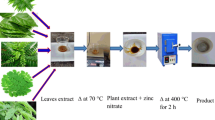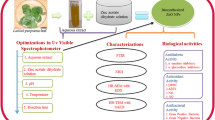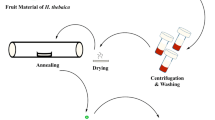Abstract
During the present century, plant-based zinc oxide nanoparticles (ZnO-NPs) are exploited extensively for their vast biological properties due to their unique characteristic features and eco-friendly nature. Diabetes is one of the fast-growing human diseases/abnormalities worldwide, and the need for new/ novel antiglycation products is the need of the hour. The study deals with the phyto-fabrication of ZnO-NPs from Boerhaavia erecta, a medicinally important plant, and to evaluate their antioxidant and antiglycation ability in vitro. UV-visible spectroscopy (UV-Vis), X-ray diffraction (XRD), Fourier-transform infrared spectroscopy (FT-IR), scanning electron microscopy (SEM), and energy dispersive spectroscopy (EDS) were used to characterize the phyto-fabricated ZnO-NPs. The characterization of nanoparticles revealed that the particles showed an absorption peak at 362 nm and band gap energy of 3.2 eV, approximately 20.55 nm in size, with a ZnO elemental purity of 96.61%. The synthesized particles were found agglomerated when observed under SEM, and the FT-IR studies proved that the phyto-constituents of the extract involved during the different stages (reduction, capping, and stabilization) of nanoparticles synthesis. The antioxidant and metal chelating activities confirmed that ZnO-NPs could inhibit the free radicals generated, which was dose-dependent with an IC50 value between 1.81 and 1.94 mg mL–1, respectively. In addition, the phyto-fabricated nanoparticles blocked the formation of advanced glycation end products (AGEs) as noticed through inhibition of Amadori products, trapping of reactive dicarbonyl intermediate and breaking the cross-link of glycated protein. It was also noted that the phyto-fabricated ZnO-NPs significantly prevented the damage of red blood corpuscles (RBCs) induced by MGO. The present study’s findings will provide an experimental basis for exploring ZnO-NPs in diabetes-related complications.






Similar content being viewed by others
Data availability
Not applicable.
References
Agarwal H, Shanmugam V (2020) A review on anti-inflammatory activity of green synthesized zinc oxide nanoparticle: mechanism-based approach. Bioorg Chem 94:103423
Ahmad S, Dixit K, Shahab U, Alam K, Ali A (2011) Genotoxicity and immunogenicity of DNA-advanced glycation end products formed by methylglyoxal and lysine in presence of Cu2+. Biochem Biophys Res Commun 407(3):568–574
Ahmed N (2005) Advanced glycation endproducts - role in pathology of diabetic complications. Diabetes Res Clin Pract 67(1):3–21
Alamdari S, Sasani Ghamsari M, Lee C, Han W, Park HH, Tafreshi MJ, Afarideh H, Ara MHM (2020) Preparation and characterization of zinc oxide nanoparticles using leaf extract of Sambucus ebulus. Appl Sci 10(10):3620
Ali SG, Ansari MA, Jamal QMS, Almatroudi A, Alzohairy MA, Alomary MN, Rehman S, Murali M, Jalal M, Khan HM, Adil SF (2021) Butea monosperma seed extract mediated biosynthesis of ZnO NPs and their antibacterial, antibiofilm and anti-quorum sensing potentialities. Arab J Chem 14(4):103044
Anandan S, Urooj A (2019) Bioactive compounds from Morus indica as inhibitors of advanced glycation end products. Ind J Pharm Sci 81(2):282–292
Anandan S, Murali M, Ansari MA, Alzohairy MA, Alomary MN, Farha Siraj S, HaluguddeNagaraja S, Mahendra C, Lakshmeesha TR, Hemanth Kumar NK, Ledesma AE, Amruthesh KN, Asna U (2019) Biosynthesized ZnO-NPs from Morus indica attenuates methylglyoxal-induced protein glycation and RBC damage: in-vitro, In-vivo and molecular docking study. Biomolecules 9:882
Arumugam M, Manikandan DB, Dhandapani E, Sridhar A, Balakrishnan K, Markandan M, Ramasamy T (2021) Green synthesis of zinc oxide nanoparticles (ZnO NPs) using Syzygium cumini: potential multifaceted applications on antioxidants, cytotoxic and as nanonutrient for the growth of Sesamum indicum. Environ Technol Innov 23:101653
Ashraf JM, Ansari MA, Khan HM, Alzohairy MA, Choi I (2016) Green synthesis of silver nanoparticles and characterization of their inhibitory effects on AGEs formation using biophysical techniques. Sci Rep 6:20414
Awasthi S, Gayathiri SK, Ramya R, Duraichelvan R, Dhason A, Saraswathi NT (2015) Advanced glycation-modified human serum albumin evokes alterations in membrane and eryptosis in erythrocytes. Appl Biochem Biotechnol 177(5):1013–1024
Basnet P, Chanu TI, Samanta D, Chatterjee S (2018) A review on bio-synthesized zinc oxide nanoparticles using plant extracts as reductants and stabilizing agents. J Photochem Photobiol B Biol 183:201–221
Biancalana M, Koide S (2010) Molecular mechanism of Thioflavin-T binding to amyloid fibrils. Biochim Biophys Acta 7:1405–1412
Bolton WK, Cattran DC, Williams ME, Adler SG, Appel GB, Cartwright K, Foiles PG, Freedman BI, Raskin P, Ratner RE, Spinowitz BS (2004) Randomized trial of an inhibitor of formation of advanced glycation end products in diabetic nephropathy. Ame J Nephrol 24(1):32–40
Dinga E, Mthiyane DMN, Marume U, Botha TL, Horn S, Pieters R, Wepener V, Ekennia A, Onwudiwe DC (2022) Biosynthesis of ZnO nanoparticles using Melia azedarach seed extract: evaluation of the cytotoxic and antimicrobial potency. OpenNano 8:100068
Elosta A, Ghous T, Ahmed N (2012) Natural products as anti-glycation agents: possible therapeutic potential for diabetic complications. Curr Diabetes Rev 8(2):92–108
Gunalan S, Sivaraj R, Rajendran V (2012) Green synthesized ZnO nanoparticles against bacterial and fungal pathogens. Prog Nat Sci: Mater Inter 22(6):693–700
IDF Diabetes Atlas (2015) International Diabetes Federation, 7th edn. IDF, Brussels, Belgium, pp 33
Khan ZUH, Sadiq HM, Shah NS, Khan AU, Muhammad N, Hassan SU, Tahir K, Zamnsafi S, Khan FU, Imran M, Ahmad N, Ullah F, Ahmad A, Sayed M, Khalid MS, Qaisrani SA, Ali M, Zakir A (2019) Greener synthesis of zinc oxide nanoparticles using Trianthema portulacastrum extract and evaluation of its photocatalytic and biological applications. J Photochem Photobiol B Biol 192:147–157
Kumar NKH, Murali M, Satish A, Singh SB, Gowtham HG, Mahesh HM, Lakshmeesha TR, Amruthesh KN, Jagannath S (2020) Bioactive and biocompatible nature of green synthesized zinc oxide nanoparticles from Simarouba glauca DC.: an endemic plant to Western Ghats. India J Clust Sci 31:523–534
Lee J, Yun JS, Ko SH (2022) Advanced glycation fend products and their effect on vascular complications in Type 2 diabetes mellitus. Nutrients 14(15):3086
LeVine H (1999) Quantification of β-sheet amyloid fibril structures with thioflavin T. Methods Enzymol 309:274–284
Losso JN, Bawadi HA, Chintalapati M (2011) Inhibition of the formation of advanced glycation end products by thymoquinone. Food Chem 128:55–61
Monnier VM (2003) Intervention against the Maillard reaction in vivo. Archiv Biochem Biophy 419(1):1–5
Murali M, Mahendra C, Rajashekar N, Sudarshana MS, Raveesha KA, Amruthesh KN (2017) Antibacterial and antioxidant properties of biosynthesized zinc oxide nanoparticles from Ceropegia candelabrum L.– An endemic species. Spectrochim Acta Part A Mol Biomol Spectrosc 179:104–109
Murali M, Anandan S, Ansari MA, Alzohairy MA, Alomary MN, Asiri SMM, Almatroudi A, Thrivveni MC, Brijesh Singh S, Gowtham HG, Aiyaz M, Chandrashekar S, Urooj A, Amruthesh KN (2021a) Genotoxic and cytotoxic properties of zinc oxide nanoparticles phyto-fabricated from the obscure morning glory plant Ipomoea obscura (L.) Ker Gawl. Molecules 26(4):891
Murali M, Kalegowda N, Gowtham HG, Ansari MA, Alomary MN, Alghamdi S, Shilpa N, Singh SB, Thriveni MC, Aiyaz M, Angaswamy N, Lakshmidevi N, Adil SF, Mohammad RH, Amruthesh KN (2021b) Plant-mediated zinc oxide nanoparticles: advances in the new millennium towards understanding their therapeutic role in biomedical applications. Pharmaceutics 13(10):1662
Murali M, Manjula S, Shilpa N, Ravishankar DK, Shivakumara CS, Thampy A, Ayeshamariam A, Pandey S, Anandan S, Amruthesh KN, Al-Mekhlafi FA, Kaviyarasu K (2022) Facile synthesis of ZnO-NPs from yellow creeping daisy (Sphagneticola trilobata L.) attenuates cell proliferation by inducing cellular level apoptosis against colon cancer. J King Saud Univ Sci 34(5):102084
Nagajyothi P, Cha SJ, Yang IJ, Sreekanth T, Kim KJ, Shin HM (2015) Antioxidant and anti-inflammatory activities of zinc oxide nanoparticles synthesized using Polygala tenuifolia root extract. J Photochem Photobiol B Biol 146:10–17
Nagaraj RH, Shipanova IN, Faust FM (1996) Protein cross-linking by the Maillard reaction: isolation, characterization, and in vivo detection of a lysine-lysine cross-link derived from methylglyoxal. J Biol Chem 271(32):19338–19345
Nisha M, Vinod BN, Sunil C (2018) Evaluation of Boerhavia erecta L. for potential antidiabetic and antihyperlipidemic activities in streptozotocin-induced diabetic Wistar rats. Future J Pharm Sci 4(2):150–155
Patil N, Kelkar A, Sivaram A (2022) Prevention of protein glycation by nanoparticles: potential applications in T2DM and associated neurodegenerative diseases. BioNanoScience 18:1–3
Prasanna G, Saraswathi N (2016) Aspartic acid functions as carbonyl trapper to inhibit the formation of advanced glycation end products by chemical chaperone activity. J Biomol Struct Dyn 34:943–951
Prasanna G, Hari N, Saraswathi NT (2018) Hydroxymethoxybenzaldehyde from Sesbania grandilfora inhibits the advanced glycation end products (AGEs)-mediated fibrillation in hemoglobin. J Biomol Struct Dyn 36(4):819–829
Rahbar S, Yerneni KK, Scott S, Gonzales N, Lalezari I (2000) Novel inhibitors of advanced glycation endproducts (part II). Mol Cell Biol Res Commun 3:360–366
Ramesh AM, Pal K, Kodandaram A, Manjula BL, Ravishankar DK, Gowtham HG, Murali M, Rahdar A, Kyzas GZ (2022) Antioxidant and photocatalytic properties of zinc oxide nanoparticles phyto-fabricated using the aqueous leaf extract of Sida acuta. Green Process Synth 11(1):857–867
Sajjad A, Bhatti SH, Ali Z, Jaffari GH, Khan NA, Rizvi ZF, Zia M (2021) Photoinduced fabrication of zinc oxide nanoparticles: transformation of morphological and biological response on light irradiance. ACS Omega 6(17):11783–11793
Sengani M, Rajeswari D (2017) Gold nanosupplement in selective inhibition of methylglyoxal and key enzymes linked to diabetes. IET Nanobiotechnol 11(7):861–865
Sharma D, Kanchi S, Bisetty K (2019) Biogenic synthesis of nanoparticles: a review. Arab J Chem 12(8):3576–3600
Singh VP, Bali A, Singh N, Jaggi AS (2014) Advanced glycation end products and diabetic complications. Korean J Physiol Pharmacol 18(1):1–14
Sirelkhatim A, Mahmud S, Seeni A, Kaus NHM, Ann LC, Bakhori SKM, Hasan H, Mohamad D (2015) Review on zinc oxide nanoparticles: antibacterial activity and toxicity mechanism. Nano-Micro Lett 7:219–242
Soren S, Kumar S, Mishra S, Jena PK, Verma SK, Parhi P (2018) Evaluation of antibacterial and antioxidant potential of the zinc oxide nanoparticles synthesized by aqueous and polyol method. Microb Pathog 119:145–151
Stan M, Popa A, Toloman D, Silipas TD, Vodnar DC (2016) Antibacterial and antioxidant activities of ZnO nanoparticles synthesized using extracts of Allium sativum, Rosmarinus officinalis and Ocimum basilicum. Acta Met Sin Engl Lett 29:228–236
Surange SR, Pendse GS (1972) Pharmacognostical studies of Boerhaavia Gaert. and its comparison with Boerhaavia diffusa Linn. Quarterly journal. Crude Drug Res 12(3):1937–1950
Udayashankar AC, Shivaram AB, Murali M, Ramachndrappa LT, Lalitha SG, Krishnappa HKN, Anandan S, Sudarshana BS, Chanappa EG, Ramachandrappa NS (2021) Biosynthesis of zinc oxide nanoparticles using leaf extract of Passiflora subpeltata: characterization and antibacterial activity against Escherichia coli isolated from poultry faeces. J Clust Sci 32(6):1663–1672
Udhayan S, Udayakumar R, Sagayaraj R, Gurusamy K (2021) Evaluation of bioactive potential of a Tragia involucrata healthy leaf extract @ ZnO nanoparticles. BioNanoScience 11:703–719
Venu Gopal VR, Kamila S (2017) Effect of temperature on the morphology of ZnO nanoparticles: a comparative study. Appl Nanosci 7(3):75–82
Younus H, Anwar S (2016) Prevention of non-enzymatic glycosylation (glycation): implication in the treatment of diabetic complication. Inter J Health Sci 10(2):261
Zhang J, Sun LD, Lin YJ, Su H, Liao C, Yan C (2002) Control of ZnO morphology via a simple solution route. Chem Mater 14:4172–4177
Acknowledgements
The authors thank the Department of Studies in Botany, Biotechnology and Microbiology of the University of Mysore, Mysuru, for providing facilities to carry out research. The authors would also like to thank the University with Potential of Excellence (UPE) Authorities University of Mysore, Mysuru, for instrumentation facilities.
Funding
The author M. Murali likes to acknowledge the University Grants Commission (UGC), New Delhi, India, for providing financial support by awarding a Post-Doctoral Fellowship (No. F/PDFSS-2015-17-KAR-11846).
Author information
Authors and Affiliations
Contributions
All authors contributed to the study conception and design. The authors indicated in parentheses made substantial contributions to the following tasks of research: conceptualization (Mahadevamurthy Murali, Anjana Thampy, Satish Anandan, Ashween Bilagi, Mohammed Aiyaz, Natarajamurthy Shilpa, Sudarshana Brijesh Singh, Hittanahallikoppal Gajendramurthy Gowtham, Abhilash Mavinakere Ramesh, Abbas Rahdar, George Z. Kyzas); writing-original draft, writing-revised, investigation, and methodology (Mahadevamurthy Murali, Anjana Thampy, Satish Anandan, Mohammed Aiyaz, Natarajamurthy Shilpa, Sudarshana Brijesh Singh, Hittanahallikoppal Gajendramurthy Gowtham, Abhilash Mavinakere Ramesh, Abbas Rahdar, George Z. Kyzas); and supervision (Satish Anandan). All authors read and approved the final manuscript.
Corresponding author
Ethics declarations
Ethical approval
Not applicable.
Consent to participate
Not applicable.
Consent for publication
Not applicable.
Competing interests
The authors declare no competing interests.
Additional information
Responsible Editor: Philippe Garrigues
Publisher's note
Springer Nature remains neutral with regard to jurisdictional claims in published maps and institutional affiliations.
Supplementary Information
Below is the link to the electronic supplementary material.
Rights and permissions
Springer Nature or its licensor (e.g. a society or other partner) holds exclusive rights to this article under a publishing agreement with the author(s) or other rightsholder(s); author self-archiving of the accepted manuscript version of this article is solely governed by the terms of such publishing agreement and applicable law.
About this article
Cite this article
Murali, M., Thampy, A., Anandan, S. et al. Competent antioxidant and antiglycation properties of zinc oxide nanoparticles (ZnO-NPs) phyto-fabricated from aqueous leaf extract of Boerhaavia erecta L.. Environ Sci Pollut Res 30, 56731–56742 (2023). https://doi.org/10.1007/s11356-023-26331-8
Received:
Accepted:
Published:
Issue Date:
DOI: https://doi.org/10.1007/s11356-023-26331-8




